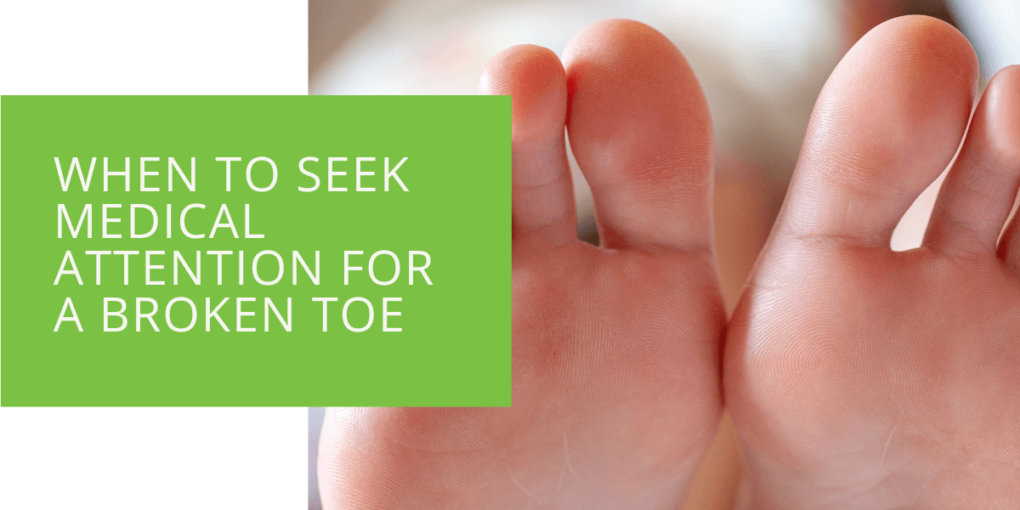When to Seek Medical Attention for a Broken Toe
A broken toe is a common foot injury caused by various factors, including trauma, repetitive stress, and underlying medical conditions. While some broken toes can heal on their own with proper rest and care, others may require medical attention from a podiatrist. This article will discuss when to seek medical attention for a broken toe, the signs and symptoms, and the diagnosis, treatment, and prevention of this common foot injury. By providing this information, we hope to help you take the necessary steps to ensure your toe heals properly and reduce the risk of long-term complications.
Signs and Symptoms of a Broken Toe
The signs and symptoms of a broken toe include:
- Pain and tenderness
- Swelling and bruising
- Difficulty walking or standing
- Deformity or misalignment of the toe
If you experience any of these symptoms, seeking medical attention from a podiatrist is important. Sometimes, a broken toe may not show obvious signs of injury, making it difficult to detect. A podiatrist can perform a physical examination and order imaging tests to diagnose a broken toe accurately.
When to Seek Emergency Medical Care
In some cases, a broken toe may require emergency medical care. If you experience any of the following symptoms, seek medical attention immediately:
- Open fracture
- Excessive bleeding
- Severe deformity or misalignment
- Inability to move the toe
An open fracture occurs when the bone breaks through the skin, which can lead to infection. Excessive bleeding can be a sign of a severe injury that requires immediate medical attention. Severe deformity or misalignment of the toe can lead to long-term complications if not treated promptly. If you cannot move the toe, it is important to seek medical attention to ensure the injury is not more severe than initially thought.

When to See a Podiatrist
If you suspect you have a broken toe, seeing a podiatrist for a proper diagnosis and treatment is crucial. You should see a podiatrist if you experience:
- Persistent pain and swelling
- Bruising that does not improve
- Numbness or tingling in the toe
- Signs of infection
A podiatrist can perform a physical examination and order imaging tests, such as an x-ray, to diagnose a broken toe accurately. They can also provide expert advice on the best treatment options based on the severity of the injury.
Diagnosis and Treatment
A podiatrist can diagnose a broken toe by performing a physical examination and ordering imaging tests. During the physical examination, the podiatrist will assess the toe's range of motion, check for any deformities, and test for nerve damage. An x-ray can confirm the diagnosis and determine the extent of the fracture.
The treatment for a broken toe depends on the severity of the injury. Treatment options include:
- Rest, ice, compression, and elevation (RICE): The first-line treatment for a broken toe is to rest the injured foot, apply ice to the affected area, and keep the foot elevated to reduce swelling. Compression can also help reduce swelling.
- Immobilization with a cast or splint: A podiatrist may recommend immobilizing the broken toe with a cast or splint to promote healing and prevent further injury.
- Surgery: Surgery may be necessary in severe cases of a broken toe where the bone has broken through the skin, or the toe is severely misaligned. Surgery may involve realigning the bone and fixing it in place with screws, pins, or plates.
- Pain management: Over-the-counter pain medication can help relieve pain and reduce inflammation. A podiatrist may prescribe prescription pain medication or recommend nerve blocks to reduce pain in severe cases.

Recovery and Prevention
Recovery from a broken toe can take several weeks to several months, depending on the severity of the injury. During recovery, it is essential to follow a podiatrist's instructions and avoid putting weight on the injured foot. A podiatrist may recommend physical therapy or rehabilitation exercises to help the toe heal properly and restore mobility.
Regular follow-up appointments with a podiatrist are necessary to monitor the healing progress and ensure the toe is healing correctly. In addition to medical treatment, preventative measures can be taken to reduce the risk of a broken toe.
These measures include wearing proper footwear that fits well and provides adequate support, avoiding high-risk activities that may lead to toe injuries, and maintaining a healthy lifestyle with a balanced diet and regular exercise.
Buddy taping is also popular for preventing broken toes, especially in athletes. It involves taping the injured toe to the adjacent toe for support and stability. The tape provides compression, which helps reduce swelling and promotes healing. However, it's important to note that buddy taping should only be done under the guidance of a podiatrist to avoid further injury or complications.
Conclusion
A broken toe is a painful foot injury that requires medical attention from a podiatrist to ensure proper healing and prevent long-term complications. If you experience any signs or symptoms of a broken toe, seek medical attention immediately. A podiatrist can diagnose the injury, recommend a treatment plan, and provide expert advice to ensure the toe heals properly. Following the proper treatment and preventative measures can reduce the risk of a broken toe and keep your feet healthy and pain-free.

